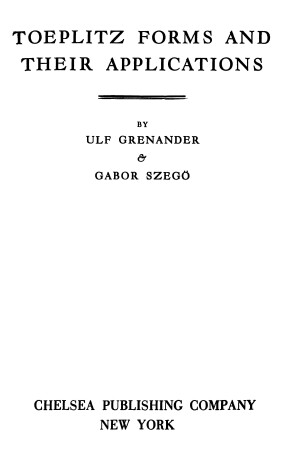AMS Chelsea Publishing
2 total works
Statistical Analysis of Stationary Time Series
by Ulf Grenander and Murray Rosenblatt
Published 1 January 1999
From the Preface to the First Edition (1957): 'The purpose of this book is two-fold. It is written in the terminology of the theoretical statistician because one of our objectives is to direct his attention to an approach to time series analysis that is essentially different from most of the techniques used by time series analysts in the past. The second objective is to present a unified treatment of methods that are being used increasingly in the physical sciences and technology. We hope that the book will be of considerable interest to research workers in these fields. Keeping the first objective in mind, we have given a rigorous mathematical discussion of these new topics in time series analysis. The existing literature in time series analysis is characterized with few exceptions by a lack of precision both in conception and in the mathematical treatment of the problems dealt with.To avoid this vagueness, we have devoted more space to rigorous proofs than may appear necessary to some readers, but we believe that a study of the proofs will furnish valuable clues to the practical validity of the results and be an important guide to intuition.
We have tried to balance the formal proofs with intuitive remarks and comments on practical applications. While the regularity assumptions we have required in many cases may seem restrictive, appropriately interpreted they give an indication of the range in which the methods are practically valid. We have made such interpretations in the comments accompanying the formal proofs. Readers should have knowledge of statistics and basic probability. The second edition was printed with corrections.
We have tried to balance the formal proofs with intuitive remarks and comments on practical applications. While the regularity assumptions we have required in many cases may seem restrictive, appropriately interpreted they give an indication of the range in which the methods are practically valid. We have made such interpretations in the comments accompanying the formal proofs. Readers should have knowledge of statistics and basic probability. The second edition was printed with corrections.
From the Preface (1955): The first part of the present exposition is devoted to the theory of Toeplitz forms. The second part deals with applications, in particular to the calculus of probability and mathematical statistics. Neither part claims completeness in any way. Our purpose has been to elucidate the principal ideas of this remarkable chapter of modern analysis and to help the interested student of mathematical statistics to acquire a working knowledge of the subject. The somewhat protracted Chapter 1 explains not only the notation employed but contains also the definition of important auxiliary concepts and the exposition of basic results which will be used later.This arrangement avoids interruptions in the main text...[It is assumed] that the reader is in possession of the fundamental facts of the theory of functions. ""In chapters 2 and 3 certain topics appear which were treated in the book on orthogonal polynomials by G. Szego. In view of the progress made in this subject since the publication of that book (1939) it was possible to bring some details in an improved setting. The other chapters contain partly old and partly more recent results, some older facts in a new setting, and finally some completely new results. Chapter 1-6 and Chapter 9 have been prepared by Szego, the other chapters by Grenander..."".

